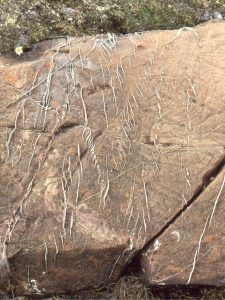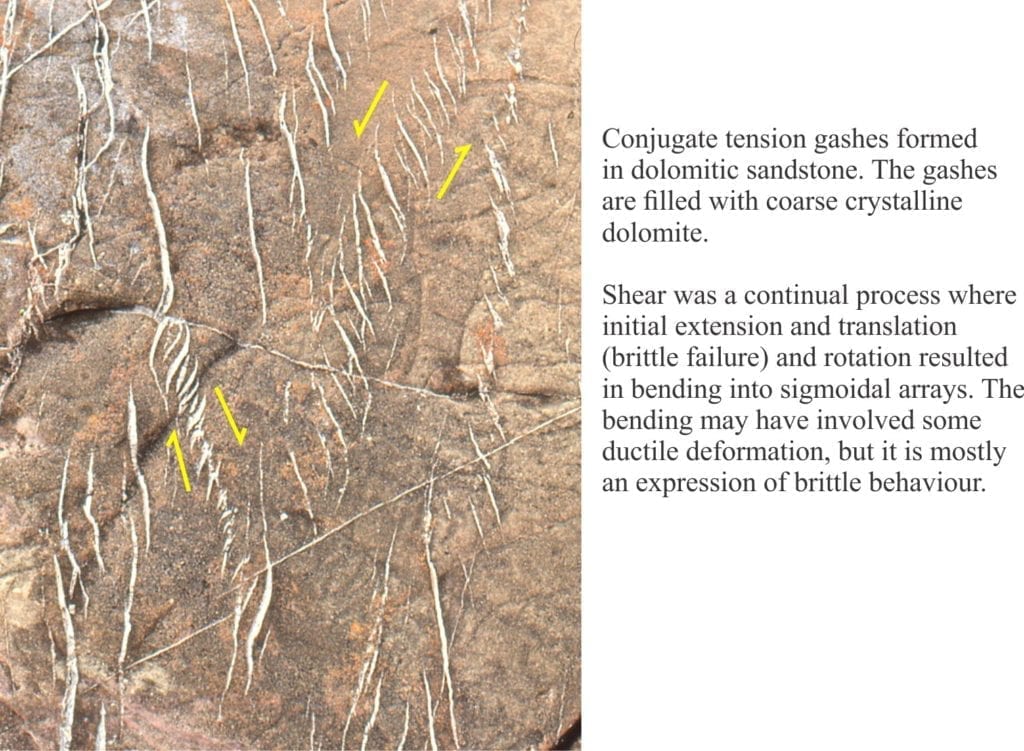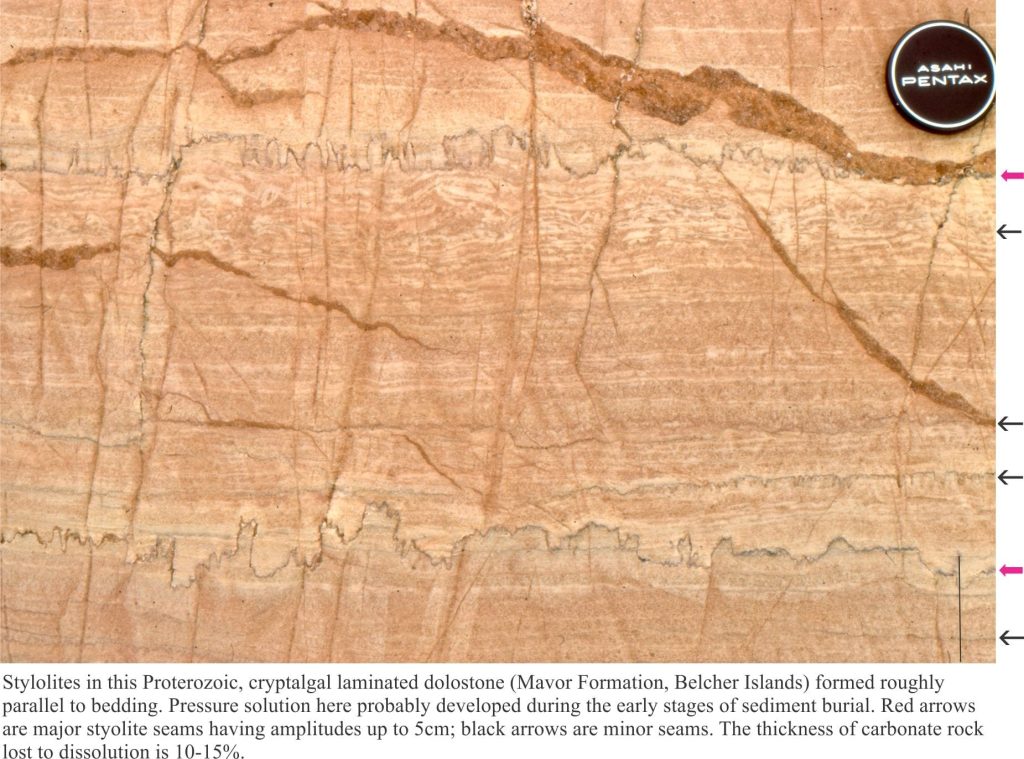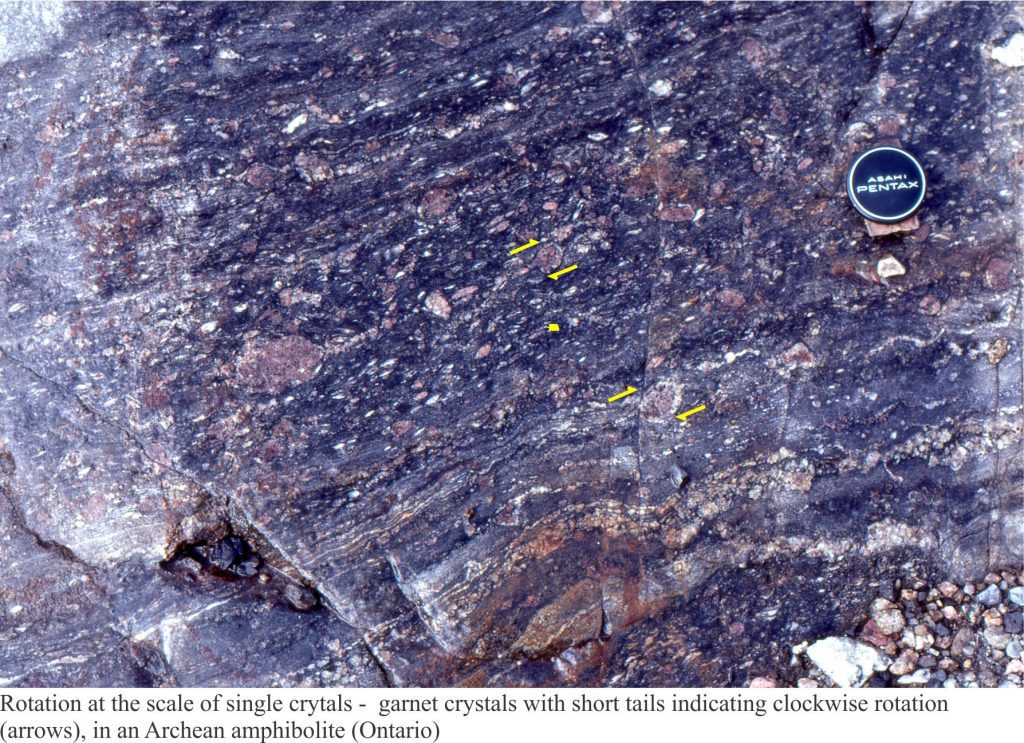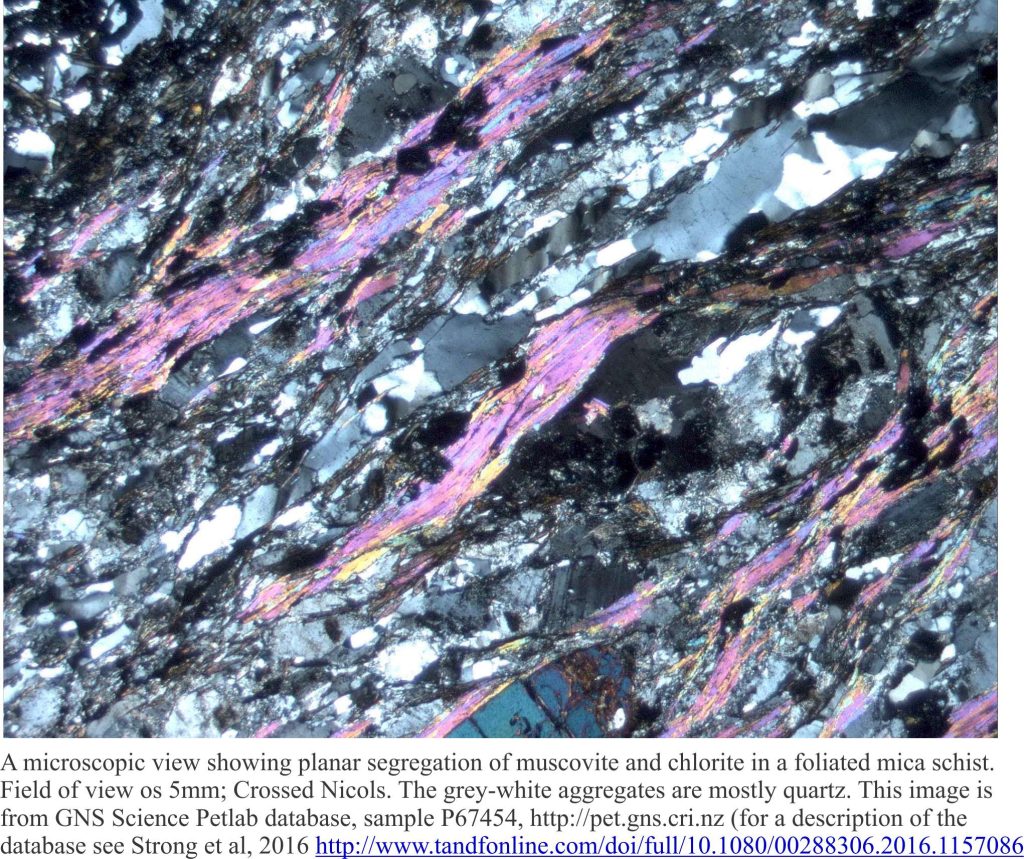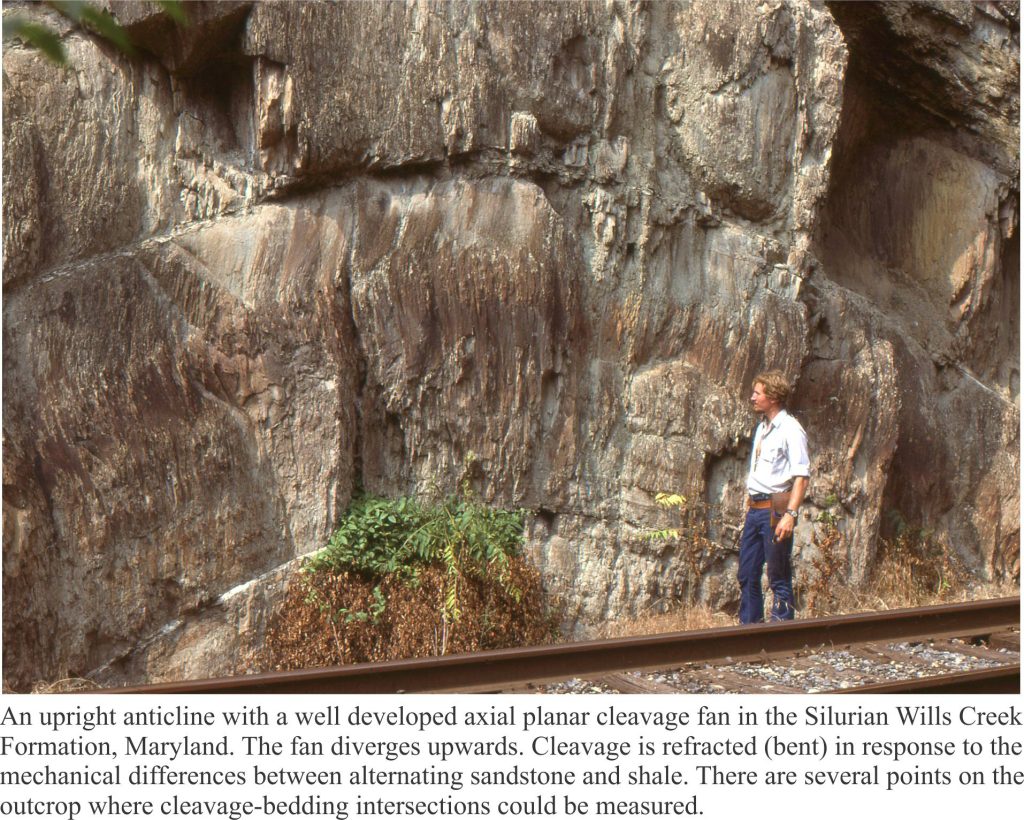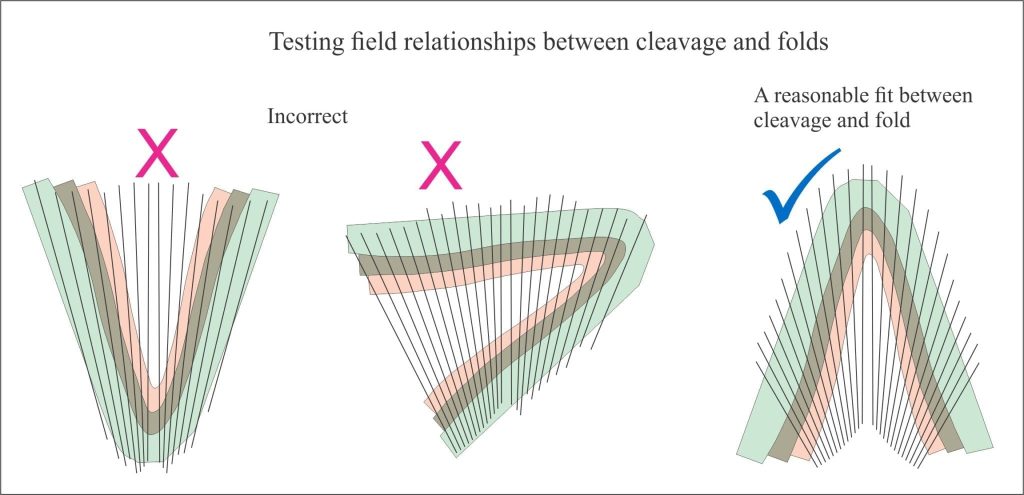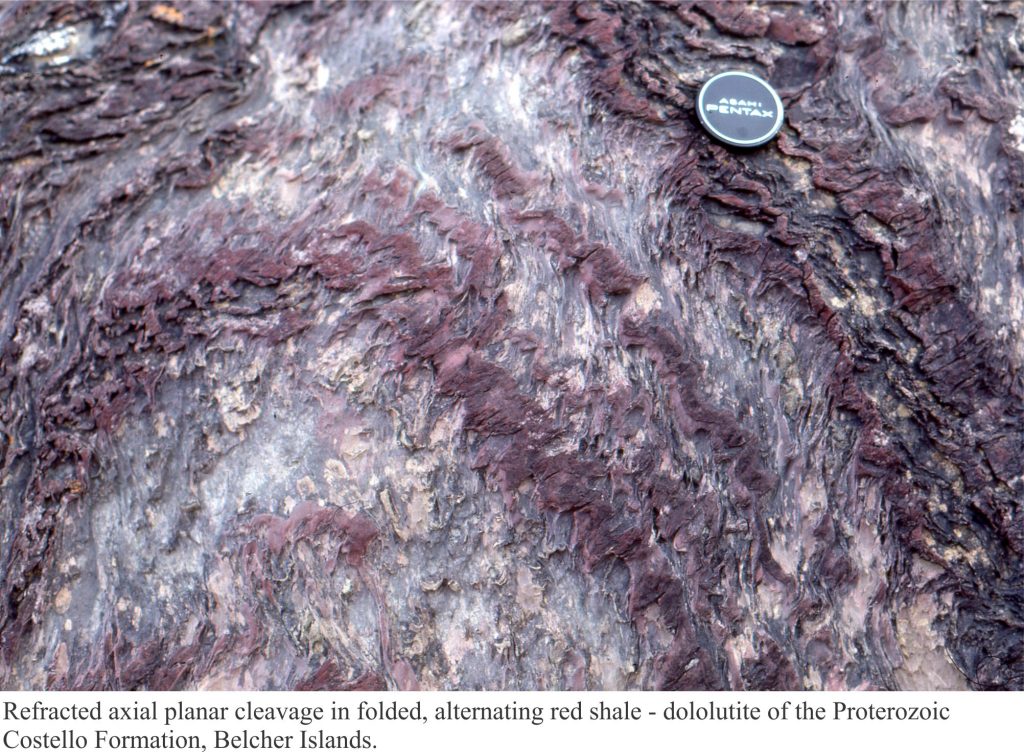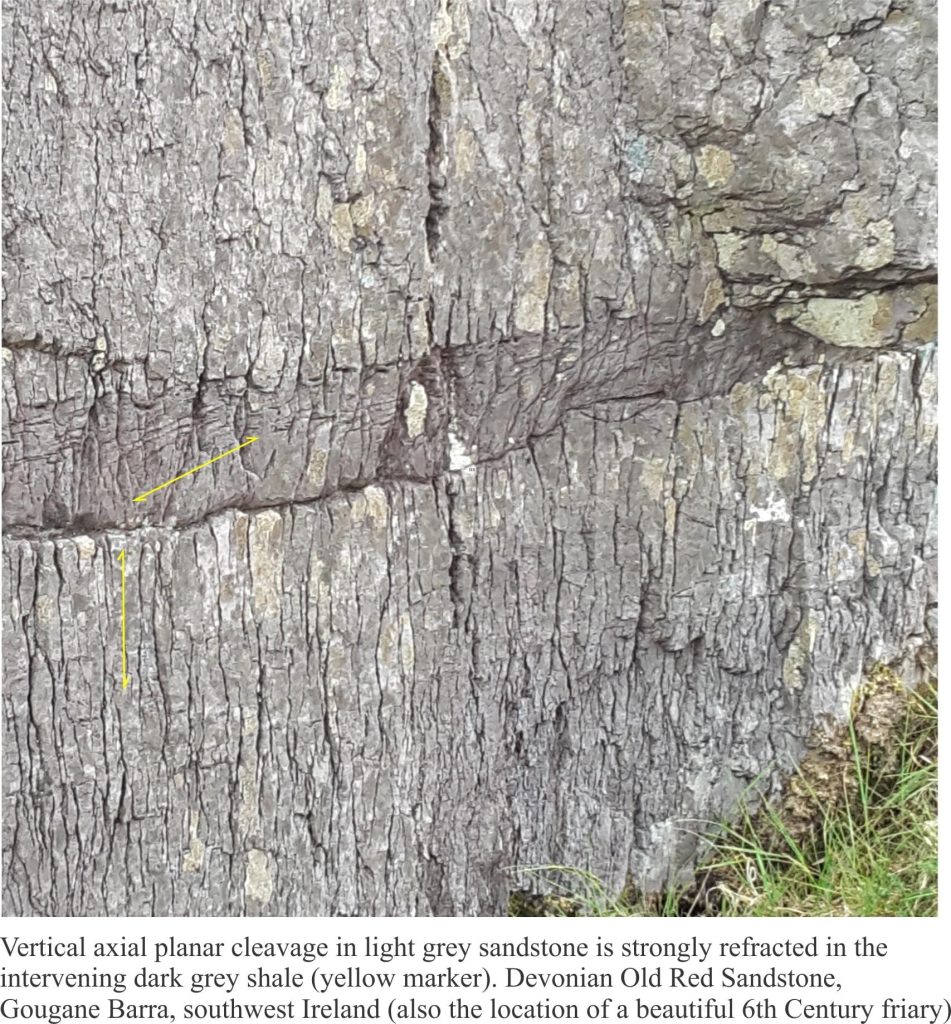Angle of internal friction: A rock or material property that refers to its ability to resist deformation, and is measured as the angle between the normal stress and a resultant stress at the point where shear begins. It is an essential parameter in the quantification of rock deformation. Cf. angle of repose.
Anticline: Convex upward or outward folds, where layers are stratigraphically younger in the convex direction. Cf. antiform, syncline.
Antiform: Convex upward folds; the name is reserved for folds where stratigraphic younging, or facing directions are unknown. If younging direction is known, the name anticline is used. Cf. Synform.
Antithetic faults: Subsidiary or minor faults that have a sense of displacement opposite that of a master fault or principal deformation zone. They occur in extensional regimes (such as accommodation in the hanging wall of listric faults), compressional regimes as back-thrusts, and strike-slip faults. Opposing subsidiary structures are synthetic where the displacement has the same shear sense as the master fault. Antithetic and synthetic faults commonly occur in parallel arrays. Cf. Riedel shears.
Back thrust: A thrust that has vergence opposite the dominant trend of a thrust system. In many cases back thrust vergence will be towards the hinterland, i.e. thrust plane dip is towards the foreland.
Blind thrust: A thrust that does not breach the surface at the time of its formation. Blind thrust tip points (tip lines) typically contain fault propagation fold pairs.
Branch point: Locations along a thrust where branching or fault splays are generated.
Brittle behaviour (rheology): Most Earth materials behave elastically up to their elastic limit, beyond which deformation is irreversible. If the strain rate is high, this deformation will take place as sudden fracturing (e.g. broken glass). Brittle deformation is also enhanced by low confining pressures and low temperatures – these are the conditions that lead to faulting and fracturing during an earthquake. Cf. Ductile flow.
Cataclastite: Fine ground-up bedrock produced by grinding during faulting. The grain size range is >0.1 mm and <10 mm. Clasts are angular. There is no preferred orientation. The difference between a cataclastite and fault breccia is mainly in the degree of induration in the former.
Cleavage (structural): A regularly spaced planar to curviplanar foliation, that is a plane of weakness in metamorphic or strained rock, caused by the growth and alignment of platy minerals like muscovite. It is a penetrative fabric, pervasive at macro and micro-scales. In folded rock the intersection of cleavage with bedding is a lineation that parallels the fold axis.
Clints: Fracture networks in limestones formed by surface (meteoric) dissolution. They are common karst landscapes and occur sympathetically with grykes.
Compressibility: The ability of a fluid or rock to change its volume in concert with changing stress, for example changing lithostatic pressures during sediment burial. It is usually expressed as the ratio of relative volume change (V) with pressure (P):
β = 1/V. (δV/δP)
Water has very low compressibility – at 6000 psi (41.4 MPa) (equivalent to 3.2 km water depth) the change in volume is 1.8%. Mudstone is highly compressible; halite is not. Compression results in a loss of porosity and permeability., and an increase in density.
Compression: The application of stress that results in shortening of a rock body, or the reduction in volume of sediment, rock, or fluid. Shortening my occur through the entire body, or along faults. It is the opposite of extension. Compression can be represented as an axis, or axes on a strain ellipse.
Confining pressure: For a body of rock at any depth, confining pressure is the combination of hydrostatic and lithostatic pressures. An increase in confining pressure results in an increase in rock strength – the stress required to deform the rock. For normal stress conditions, the confining pressure axes in the stress ellipsoid are σ2 and σ3 (σ2 = σ3).
Conjugate Riedel shears: See Riedel shears.
Conjugate faults: Fault pairs where the fault planes intersect at (commonly) 60o such that the direction of minimum extension bisects this angle, and the direction of maximum extension bisects the obtuse angle (~120o). Conjugate faults occur in dip-slip and strike-slip structural domains.
Critical taper theory: A mechanical theory used to explain the formation of wedge-shaped fold-thrust belts and accretionary prisms. During compression the slope, and therefore the angle of the wedge taper reaches a critical point depending on the strength of the materials, the frictional forces along the décollement, and the slope of that surface. As the critical slope or taper angle is approached, the materials within the wedge will deform – once the critical taper is reached, the entire mass slides along the décollement and there is little subsequent internal deformation of materials.
Cylindrical folds: Most folds can be described as cylindrical (imagine the cross-section of a soup can), or they contain segments that can be inscribed by (imaginary) cylindrical curves of different diameters. The concept is very useful for stereonet analysis because the dips and strikes on each limb (plotted as great circles) will intersect at a point corresponding to the fold axis bearing and plunge. All cylindrical folds have (straight) fold axes and (flat) axial planes.
Décollement: Also detachment, sole thrust. Names given to the thrust at the base of a thrust stack, that is the common surface of detachment for all thrusts. It overlies undeformed rocks (e.g. Cratonic platform, crystalline basement). An example is shown in the fold-thrust cross section below.
Delamination: The decoupling, or separation of upper crust from lower crust and/or mantle lithosphere. The main driving mechanism is negative buoyancy in the mantle lithosphere such that it detaches from the crust and sinks into the asthenosphere. Delamination commonly occurs above crustal-scale thrust faults.
Detachment: see décollement
Dextral: Something that moves or is located to the right. In fault terminology it is synonymous with right-lateral. Cf. Sinistral.
Dilation (kinematics): Non-rigid body deformation causing a change in size (e.g. contraction). One mechanism to accomplished this is pressure solution like: common examples are stylolites in limestones, and cleavage in highly deformed rock.
Dip: Dip is the angle of inclination measured from a horizontal line at right angles to strike. It is the maximum inclination of a plane; at any other angle that lies in the plane, the dip is apparent.
Dip slip: The component of movement, or slip along a fault plane that parallels dip. It may be normal or reverse dip slip.
Dip slope: The flank of a ridge underlain by a steeply dipping resistant layer of rock, typically sedimentary. Dips are usually >30-40°. Hogbacks and Flatirons are usually identified by their dip slopes.
Distortion (kinematics): Non-rigid body deformation involving a change of shape; commonly by ductile flow. For example, boudinage of thinly bedded sandstone-shale will involve brittle failure and translation, and possibly rotation of sandstone boudins, and ductile flow of the mechanically less competent shale.
Drag fold: Folds produced during faulting as a result of shear strain distributed beyond the fault plane into the adjacent rock. They are useful (kinematic) indicators of fault displacement.
Drape fold: Strata deformed as folds over pre-existing structures or topography. Drape folding can occur in soft sediment or as ductile deformation in indurated rock.
Ductile deformation (flow): Deformation (strain) beyond a material’s elastic limit that is permanent (not reversible), but does not result in fracturing (brittle failure) – i.e. the material is behaving as a plastic. Materials that deform ductily appear to flow or bend. Ductile deformation of rock is enhanced under conditions of high confining pressures, high temperatures, and low strain rates.
Duplex: An imbricate stack of horses bound above and below by through-going thrusts; these are the roof and floor thrusts. Duplexes represent progressive, incremental formation of ramps and bending folds (anticline-syncline pairs). Duplexes can take several geometric forms.
Earthquake focus: The actual point beneath the surface where an earthquake is focused. Cf epicentre.
Earthquake magnitude: Magnitude (M) reflects the severity of ground roll and shaking, and on seismograms the amplitude of the signal (usually of surface waves). M is expressed as a number (M1.8, M4.6, M7.8) up to a maximum of 10. The scale is logarithmic, such that a magnitude of 4 (104) is 100 times smaller and less energetic than M6 (106).
Elastic behaviour: This rheological behaviour describes materials that respond to stress by deforming but can return to their original state when the stress is removed. The principle was developed by Robert Hooke– Hookes Law (1660); the classic physics experiment involves a spring. The principle can also be applied to most sediments and rocks. The level of stress at which deformation becomes irreversible is called the elastic limit. Beyond the elastic limit deformation will occur as brittle failure or ductile flow.
En echelon folds: Anticline-syncline pairs that in an ideal system will be about 45o to the PDZ. Fold axes parallel the long axis of the strain ellipse – the axis of maximum extension, and bisect the angle between Riedel and conjugate Riedel shears. Fold axes will also be at right angles to extensional normal faults.
Epicenter: The projection of an earthquake focus (at depth) to the surface.
Episodic tremor: Swarms of very low magnitude earthquakes at a subduction interface and its associated faults, barely felt, if at all. None of the displacements results in major earthquakes. Associated with slow slip displacements.
Extension: The application of stress that results in an increase in length or volume of rock, sediment, or fluid. It can occur at the scale of entire continents (rifts) or single crystals and grains. It is not the same as tension!
Fault-bend folds: Folds that develop in the hanging wall where there is a change in the inclination of a fault plane. For thrust ramps, this includes a syncline above the flat-ramp transition, and anticline at the fault tip, thus producing a characteristic anticline-syncline pair. Compare this category of folds with those produced by fault propagation.
Fault breccia: Angular blocks of bedrock produced by crushing and grinding during faulting. A distinction is sometimes made between a breccia made up of clasts >1 mm and <0.5 m, and megabreccia with clasts >0.5 m. An important difference among fault breccia, gouge, and cataclastite is the high degree of induration in the latter. Cf. cataclastite, gouge.
Fault conduit: The open, dilational part of a fault between fracture planes. Conduit width, or aperture, is measured normal to fracture surfaces. The width can vary considerably along the length of a fault. Fault conduits provide access for fluid flow.
Fault core: In hydrogeology, this is the primary zone along the fault plane, and can be presented as an open conduit, a zone of fractured rock and gouge, or a zone of mud-shale lithologies that have been smeared along the fault plane during fault shear. The permeability of the core will depend on the relative proportions of these attributes.
Fault damage zone: The zone either side of the fault plane or fault core that where the host rock is damaged by fracturing and cataclasis. The degree of damage decreases with increasing distance from the core. The intensity of deformation depends primarily on the magnitude of fault displacement.
Fault gouge: Very fine ground-up rock along a fault plane of fault zone. Gouge materials are generally <0.1 mm. Cf. fault breccia, cataclastite.
Fault heave & throw: Heave is the horizontal displacement produced by a fault; throw is the vertical displacement. Both are components of actual slip. They are measured from hanging wall and foot wall cut-offs.
Fault permeability: The permeability along the plane of the fault, primarily through the fault conduit and damage zone, and normal to a fault plane. Faults in this context provide a focus or barrier to fluid flow.
Fault plane: A plane across which rocks are displaced. In map view fault planes are projected as traces that are straight or arcuate; in 3D they are flat or curved, the latter usually concave upward (listric faults).
Fault propagation folds: Folding caused by the distribution of strain beyond a fault tip, as the thrust fault propagates. This mechanism also produces anticline-syncline pairs. A nice example from the tip of Lewis Thrust, Alberta Front Ranges, is shown below. The isoclinal fold pair in the header image (top of page) are also fault propagation folds.
Fault recurrence interval: The probability of earthquake activity along a fault, based on historical, archeological, and geological records. These assessments are dogged for known active faults by the relatively small number of recorded events.
Fault scarp: The topographic expression of a fault plane. Most scarps become degraded relatively rapidly by collapse and erosion of the uplifted block, particularly in weakly consolidated rock, sediment, or soil. These processes tend to remove direct evidence of fault slip. Trenching profiles across the fault trace is a valuable method for recovering some of this data.
Fault separation: A term used to describe the apparent displacement of fault blocks, strata, or marker units when true slip cannot be determined, or when the fault plane is not exposed.
Fault slip: The actual displacement of blocks across a fault plane. There are three basic types: dip-slip (fault blocks move up or down), strike-slip (fault blocks move laterally), and oblique-slip (components of dip- and strike-slip). Slip is indicated by fault plane structures such as slickenlines, drag folds, and tension gashes. If true slip cannot be determined, then displacement is described as apparent.
Fault splay: A single fault strand divided into two or more faults such that displacement is distributed across the new structures.
Fault trace: The surface, or map projection of a fault plane. On a map, the relative displacement is indicated by arrows or up/down (U/D) symbols.
Fault zone: Faulting that is distributed across a zone of broken rock and/or several closely spaced faults. The width of fault zones ranges from a few centimetres to many 10s of metres. Fault zones are common in weak rock and unconsolidated sediment. Crushing and grinding of rock produces fault gouge, cataclastite, and fault breccia.
Flatiron: A geomorphic term for a relatively planar, steeply dipping bedrock slope (a dip slope) that tapers from its base to a narrow pointy top. Hogbacks may contain several flatiron slopes.
Flexural flow: Where layers in a fold deform internally by layer-parallel shear or flow. This can occur in beds having low mechanical strength. It is commonly manifested as layer thickening in fold hinges, and layer thinning along fold flanks. Cf. Flexural slip.
Flexural slip: A rigid body deformation where layers in a fold slip to accommodate strain during buckling, for example along bedding planes in sedimentary rocks, or foliations in metamorphic rocks. Displacement is sometimes called a bedding plane fault. There is no change in bed thickness – cf. flexural flow. Displacement may generate slickensides.
Flower structures: Characteristic fault splays that develop at restraining and releasing bends, and at stepovers of strike-slip faults. Strain is concentrated at these locations along the fault plane so that movement along the main fault is transferred to a secondary fault; this process can be repeated several times, producing fault splays that in 3-dimensions, merge with the master fault. These splays are also called strike-slip duplexes. Flower structure refers to the cross-sectional view of duplexes. In positive flower structures (also called palm tree structures), the displacement is predominantly reverse (transpressional); in transtensional environments the displacement is normal dip slip in cross-section – these are negative flower structures or tulip structures. However, the sense of displacement can change up fault plane dip and along strike.
Fold axis: An imaginary straight hinge line in cylindrical folds. If the fold axis is moved parallel to itself it will recreate the fold; this condition does not hold for hinge lines. A fold axis must lie on the axial plane.
Fold-thrust belt: A major thrust system developed during lithosphere-scale plate convergence, with cumulative shortening of 100s of kilometres, that usually results in mountain building. The resulting topographic results in flexure and formation of a foreland basin. Thrust faults are generated in pre-existing strata, but usually evolve to include the proximal parts of the foreland basin and its sediments. An example is shown below.
Fracture networks: In hydrogeology this refers to the three-dimensional array of joints and faults for which there is interconnected permeability.
Fracture porosity: The pore space permitting fluid flow through rock fractures and joints. Fracture and joint networks are oriented according to ancient stress fields, hence the porosity will also be focused at these orientations. It tends to occur in hard rock. In crystalline or volcanic rock (the latter includes columnar joints) it is the only effective porosity.
Growth fault: Faults having a listric geometry, that are active during sedimentation. Stratigraphically they are represented by preferential sediment thickening above the downward displaced hanging wall block, and angular stratigraphic discordances. They are common on shelf, platform, and delta margins.
Grykes: Elevated blocks of limestone bound by fracture networks, or clints. They are common in karst landscapes.
Hackles: Straight to curved, low relief ridges and troughs that radiate from a point, forming plumose structure on fracture surfaces. Their point of origin is the location of fracture propagation.
Half graben: A depression or basin formed by extension, and (usually) rotation of a hanging wall block above a single, normal dip-slip fault (cf. paired faults in grabens). They commonly form above listric faults in continental rift zones, but analogous structures also form in rotational slumps.
Halokinesis: Halokinesis, or salt tectonics, studies the movement of (stratiform) salt during burial, the kinds of diapiric structures that form, the response of the surrounding bedrock (such as faulting), their impact on depositional processes, and their influence on stratigraphic architecture.
Hanging wall: Displaced fault blocks across a dipping fault plane are described as hanging wall and foot wall blocks, depending on whether they are located above or below the fault plane. Hanging wall blocks lie above – if you are standing on the fault plane, the hanging wall block will hang over your head. The term derives from old mining jargon.
Hanging wall cut-off: The intersection point of a marker layer or bed in the hanging wall block that is truncated by a fault. It is used in conjunction with the corresponding foot wall cut-off to determine fault slip.
Hinge line: A line defined by points of maximum curvature (hinge points) connected along a fold surface; the hinge line may be straight or curved. It is used with an axial surface to define the geometry of a fold. Cf. Fold axis. See also axial plane.
Hogback: A sharp-crested and symmetric ridge produced by differential erosion of resistant layers underlain by less resistant rocks. One side of the Hogback is a dip slope (dips > 25°-30°) underlain by resistant rock; The other side of the ridge is underlain by softer rock.
Hooke’s Law: First stated by Robert Hooke in 1660 then published in 1678, his experiments with springs showed that the amount of extension is proportional to the applied stress – so twice the extension requires twice the stress. This converse of this statement, that recovery of extension is also proportional to the reduced level of applied stress. Thus, Hooke’s experiments were the first to demonstrate quantitatively the elastic properties of materials. Elasticity is a fundamental property of many geological materials, particularly during deformation.
Horse: A panel of rock bound on all sides by thrusts. Duplexes are a stack of horses.
Horsetail splay: A splay of curved faults at the end of a strike-slip fault, where each strand merges with the master fault.
Horst: See Graben.
Hydrostatic stress: The condition where the stresses acting on a body of rock or fluid are the same in all directions. Under hydrostatic conditions there are no shear stresses.
Imbricate fan: Fan-like splay of thrust panels and thrust faults generated from a single décollement. Unlike duplexes, there is no roof thrust,
In sequence thrusts: In a system of thrusts, the most recent fault is at base of the thrust pile and most proximal to the foreland – propagation is towards the foreland. Older thrusts are stacked progressively hinterland-ward. In sequence thrusts place older rocks on younger as the fault propagates up the ramp through progressively younger strata.
Isoclinal fold: A fold where the interlimb angle is <30o. The beds on opposite fold limbs can sometimes appear parallel. Good younging indicators are essential for deciphering these kinds of structural complexity.
Joints: Open fractures in hard rock formed by extension. Joints lack displacement – cf faults. Joints commonly occur in three dimensional networks. Joints can form during faulting, folding, or by extension during unloading of the crust, for example during erosion, or melting of ice sheets. Open fractures provide pathways for subsurface fluid flow.
Kinematics: The branch of classical mechanics that studies movement. In Earth sciences this centres on deformed rock, the kind that produces fault zones and landslides, thrust sheets and folds, or entire mountain belts and the evolving boundaries of tectonic plates. A kinematic analysis can probe single crystals or entire mountains.
Klippe: Plural = klippen. A remnant of a thrust panel or other allochthonous structure, isolated by erosion, that overlies and is surrounded by autochthonous rock. Cf. Window.
Lateral Ramps: Fault ramps at right angles or oblique to the strike of a thrust complex that transfer displacement from a lower to higher flat. Fault planes dip 10o to 30o. As shown in the diagram below, fault displacement across the ramp is basically strike-slip.
Listric fault: Listric faults are a product of extension. They have normal dip-slip(or oblique-slip displacements where fault surfaces are concave upward, dipping steeply near the surface and flattening at depth in a detachment that is common to other listric faults. They occur at crustal scales (e.g. continental rifts), and in smaller depositional systems such as deltas and slumps. Faulting is commonly incremental and can take place during sedimentation. Rotation or folding of strata in the hanging wall block results in multiple unconformities. Cf. Growth fault
Master fault: The primary fault or detachment in a system of faults such as splays, duplexes, imbricate fans, or synthetic and antithetic shears associated with strike-slip faults. Pretty much synonymous with principle deformation zone (PDZ).
Mélange: An extensive, mappable body of brecciated and sheared rock and sediment, chaotically mixed. They tend to form in compressive, accretionary tectonic settings and are more common in subduction-related accretionary prisms. However, they are also know from strike-slip and extensional regimes where more local compressive stresses are possible.
Nappe: see Thrust nappe
Newtonian fluid: A rheological class wherein a fluid has no yield strength (cf. plastics), and deforms continuously (strain) with increasing stress, independent of viscosity. Water is the best known example.
Non-rigid deformation: Deformation where there is change in size or shape of a body. Common examples are dilation (change in size) and distortion (changes in shape). Common examples of dilation are shrinkage during dehydration or compaction; and of distortion, squished fossils, or ooids that have become ellipsoidal.
Normal fault: Steep faults (>45o where the foot wall (the wall under your feet) moves up relative to the hanging wall. It is the opposite of a reverse fault.
Normal faults/Tension gashes: Associated with strike-slip faults, normal faults are expected at releasing bends and stepovers. On the strain ellipse, fault plane strike is normal to the axes of en echelon folds and parallel to the compressional axis.
Oblique slip: Fault displacement that is a combination of dip-slip and strike-slip. Where strike-slip components dominate, the stress will be either transpressional or transtensional.
Oblique subduction: Where the trajectory of the subducting plate is not orthogonal to the trench or upper plate boundary.
Out of sequence thrusts: Basically, thrusts that don’t conform to the normal in-sequence style. They commonly form in and cut across or reactivate older thrusts. They may place younger strata over older.
P & S waves (seismology): Seismic body waves generated by an impulse (earthquake, TNT, meteor impact) that travel through Earth from the energy source. P waves push and pull materials in the same direction as the propagated waves (also called compressional waves). S waves, or shear waves produce sideways motion – motion at right angles to the propagation direction. Shear waves do not travel through liquid. P waves travel fastest (up to 7.97 km/sec in upper mantle rocks) and are the first to appear on a seismogram. See also Surface waves.
Palm tree structures: See flower structures.
Parasitic folds: Small-scale asymmetric folds that form on the limbs of larger folds. They are common in deformed rocks where flexural slip takes place along bedding planes or between layers with contrasting strength, such as mudstone and indurated sandstone. Parasitic folds are useful indicators of the geometry and orientation of their larger fold hosts – they have the same fold axis orientation. Their geometry and sense of displacement define S and Z folds on either limb of the main structure. S and Z fold vergence is towards to main fold hinge line; The short limb of a Z fold implies counterclockwise rotation, and on an S fold it is clockwise.
Passive roof thrust: A thrust that takes no part in displacement but develops passively during underthrusting or wedge insertion. Roof thrusts of triangle zones are commonly passive.
Penetrative deformation: Structures that are small compared with the size of a rock body, and repeated. The classic example is cleavage that involves alignment of minerals and some degree of pressure solution or dissolution. Adjacent cleavage planes have a degree of parallelism.
Piercing points: Identifiable marker beds, lineaments or other rock structures cut by a fault, that can be used to reconstruct the displacement or separation along that fault trace. Cf. Cut-off points that are used to determine fault slip in cross-section views.
Plastic (rheology): A material or fluid behaves plastically if it has the strength to resist deformation up to its yield strength, beyond which it deforms continuously as stress is applied, independent of viscosity. The mode of deformation is also called ductile flow.
Plunge (structural): The direction (azimuth) and angle measured from horizontal, made by a linear feature that lies in a plane; for example structural lineations, fold axes, flute casts.
Plumose structure: A collection of hackles that form a characteristic feather-like structure on fracture surfaces. The fracture planes may be flat or slightly curved. The hackles converge at a point that is the origin of fracture propagation.
Plunging fold: A fold that has been overturned such that its hinge line or axial plane plunges; the plunge is measured from horizontal.
Poles to planes: In stereographic (stereonet) analysis a great circle (representing the strike and dip of a plane) can be represented as a single point, a pole, that is 90o to the strike. A pole contains the same information as a great circle. Poles to horizontal planes will plot at the centre of the stereonet; poles to vertically dipping planes at the perimeter. Poles to planes dipping at any other angle will plot within these bounds. Poles are useful when there are many planes being analysed.
Pop-up structures: Uplifted blocks or topography formed by compression between thrusts and reverse faults that have opposing vergence, or at restraining bends and stepovers on strike-slip faults.
Pore pressure: The pressure of fluid in the pore spaces or fractures of sediment and rock; it is usually measured or calculated with reference to the expected hydrostatic pressure at the depth of interest. Pore pressures greater than hydrostatic (over-pressured) reduce the shear strength of sediment and rock. Over-pressuring cannot be maintained unless there is some fluid trapping mechanism.
Pressure solution: The dissolution of rock components (framework clasts and cements) as a result of differential compressive stress. Common products of pressure solution are stylolites. Conditions required for dissolution to take place are:
- Differential compressive stresses develop at intergranular contacts,
- Interstitial fluids must be undersaturated with respect to the mineral phase under stress,
- Dissolved components are transported from the grain contacts to regions of lower compressive stress; this requires efficient fluid movement, and
- The solute reprecipitates some distance from its point of origin.
Principal displacement zone – PDZ: The zone or plane of dip-slip or strike-slip that accounts for greatest proportion of accumulated strain. Subsidiary structures such as synthetic and antithetic faults and folds (e.g., fault splays, back-thrusts, fracture zones, en echelon folds) will be kinematically linked to the PDZ.
Principal stress directions: These are defined by the stress ellipse; the axis of greatest stress σ1 is the long axis; the least stress is the short axis σ3. The intermediate stress axis σ2 is orthogonal to σ1 and σ3 in the (3-dimensional) stress ellipsoid. Each axis represents a normal stress; i.e., there is no component of shear parallel to the axes.
Pure shear: Imagine simple compression of an object in a layered rock, such that maximum shortening is orthogonal to the layering and maximum extension is parallel to the layering. In this case, the principal axes of the strain ellipse do not rotate as deformation progresses, but they do change in length (unlike simple shear).
Recumbent fold: Any fold that has been rotated so that its axial surface is close to horizontal.
Releasing bend: Strike-slip motion at a bend in the PDZ that produces extensional structures. Pull-apart, or strike-slip basins are commonly developed at releasing bends. The left or right handedness of bends is determined by looking along the trend or strike of the fault – if the bend moves to the left, it is a left bend. Thus, a full description of the fault bend might be left-handed/releasing/sinistral or left-lateral strike-slip fault. Cf. Restraining bend, stepover.
Restraining bend: Strike-slip motion at a bend in the PDZ that produces compressional structures such as thrusts and pop-up ridges. The left or right handedness of bends is determined by looking along the trend or strike of the fault – if the bend moves to the left, it is a left bend. Cf. Releasing bend, stepover.
Reverse fault: Steep faults (>45o) where the hanging wall (the wall over your head) moves up relative to the footwall. It is the opposite of a normal fault. Thrust faults have reverse displacements but the fault plane is usually less than 45o.
Rheology: Describes the mechanical response of materials to stress. It applies to solids and fluids in Earth systems and is usually expressed as a relationship between stress and strain, or in the case of viscosity the strain rate. The three end-member behaviours are elastic, plastic (including ductile flow), and viscous behaviour. The principles can be applied to materials at the scale of the lithosphere and asthenosphere, to the behaviour of fluids in a single turbidity current.
Ridge transform: Transform faults that segment oceanic spreading ridges; they accommodate oblique spreading. Associated ridge fracture zones represent inactive ridge transforms.
Riedel shears: Parallel arrays of faults that form during the early stages of strike-slip formation. They are oriented at low angles to the principal displacement zone, commonly about 15o, and are synthetic to the PDZ. As deformation continues the Riedel shears become linked and part of the PDZ. A second set of faults at about 75o to the PDZ are conjugate to the Riedel shears and antithetic to the PDZ. The line bisecting the conjugate set parallels the direction of principal stress (on a strain ellipse this is the long axis); it also parallels the axes of en echelon folds. A third set of shears, P shears, at 10o and less to the PDZ, may form after the Riedel shears, and link with them to form the PDZ.
Right-lateral displacement: Normally used for describing the sense of movement on strike-slip faults. For an observer, the far side of the fault (the fault block opposite) will appear to move to the right. Synonymous with dextral displacement or motion.
Rigid body deformation: Deformation involving rotation or translation (position), but no change in size or shape.
Roof-floor thrusts: Major thrusts providing the upper and lower boundary faults for duplexes. At the front of the duplex a roof thrust will step down and floor thrust step up to merge into a common zone of displacement.
Rotation (kinematics): Rigid body deformation where components of shear produce a change in orientation. It may take place in concert with rigid body translation, and or distortion by ductile flow.
Sedimentary boudinage: Sedimentary layers that are pulled apart, leaving isolated pods, or boudins, that may also be rotated. There may also be microfactures through the extended layer. It is a type of soft sediment deformation. This phenomenon is most common in cohesive mudrocks that are interbedded with sandy lithologies. The stretching may be initiated by down-slope mass movement or slumping, for example on continental slopes.
Shear: The in-plane displacement of one layer parallel to another layer.
Shear strain: The result of shear stresses acting such that there is in-plane displacement of one layer parallel to another layer. Imagine a square sandwiched between the two layers; two sides will be orthogonal to the planes of the layers, the other two will be parallel. During deformation the rectangle distorts, becoming a parallelogram- the top and base remain parallel to the layers, the other two now subtend an angle less than 90o.
Simple shear: Shear deformation where the principal stress axes rotate in a strain ellipse. The axis of maximum stretching occurs in the direction of shear. cf. Pure shear.
Sinistral: Describes the sense of movement on strike-slip faults. For an observer, the far side of the fault (the fault block opposite) will appear to move to the left. Synonymous with left-lateral displacement or motion.
Slickenlines: Fine, usually linear striae on slickensided surfaces that develop during fault block movement. They are good kinematic indicators for determining the direction of slip, or displacement.
Slickensides: The polished or smooth surface on fault planes, that are generally considered the result of grinding during movement of fault blocks. However, shiny surfaces may also be a product of mineral precipitation during deformation. Slickenside surfaces commonly contain slickenlines.
Slow slip events: Small displacements along a subduction zone and its associated faults as a result of continued build-up of strain. The events occur in conjunction with episodic tremor – swarms of very low magnitude earthquakes, barely felt, if at all. None of the displacements results in major earthquakes.
Soft sediment deformation: Deformation primarily in unconsolidated or semiconsolidated, non-indurated sediment. It is most common in layered strata that contain significant contrasts in fluid content and permeability (e.g., interbedded sand and mud, or graded beds) where transient, elevated fluid pressures can develop. Compression, extension and translation can take place within the same package of deformed sediment. Common structures include a variety of fold types, faults and detachment surfaces, slumps, load structures, pull-apart structures, and fluid escape structures. Rheological behaviour can vary greatly over relatively short distances, from brittle to ductile, liquefaction and sediment flow,
Stepovers: A stepover occurs where the strain at the end of one fault is transferred to the beginning of a parallel fault having the same sense of displacement. Stepovers can be restraining or releasing. They are also described as left or right in the same way that bends are described; at the end of one fault, you look right or left to find its parallel accomplice. Pull-apart basins and pop-up ridges can also form at stepovers depending on whether they are restraining or releasing.
Stereonet: A circular grid with two sets of lines: Small circles, analogous to latitudes or parallels, and Great circles analogous to longitudes or meridians. The gird is used to graphically project a sphere onto a plane. The most common type is a Wulff net where small and great circles intersect at right angles. Stereographic projection is an important component of any geologist’s toolbox. It is used to analyse the angular relationships of planes and plane intersections (bedding, crossbedding, fault, fold axis), and linear structures that lie in those planes (lineations, rodding, cleavage-bedding intersections).
Strain (rheology): The deformation of a sediment, rock, or fluid body, that in rigid bodies is measured as changes in location (translation) or rotation, and in non-rigid bodies changes in size (dilation-contraction) and shape (distortion).
Strain analysis: Quantitative evaluation of the change in size, shape, and position of a rock body. We can analyse objects ranging in size from single crystals and grains, to large slices of the crust-lithosphere.
Strain ellipse: The diagrammatic representation of distortion in a geologic body. The degree of distortion can be quantified by measuring changes in length and angle of two, initially orthogonal ellipse axes (minor and major axes) – for example an initially spherical ooid is squished into an ellipse. In this case the two mutually perpendicular diameters will rotate; one will lengthen, the other shorten. In this way we can determine the direction and magnitude of maximum shortening or stretching. The major axis (longest) shows the direction of maximum stretching (designated S1); the minor axis at right angles is the direction of minimum stretching (S3), which in homogenous deformation corresponds to the direction of maximum shortening.
Strain rate: The rate at which deformation takes place. At high strain rates many materials will behave in a brittle manner (e.g. earthquakes). At low strain rates and high confining pressures the same materials will behave as plastics and deform by ductile flow. In fluids, shear stress is proportional to strain rate; the proportionality constant is the viscosity of that fluid (viscosity is a measure of resistance to shear deformation.
Strained quartz: Used in petrographic descriptions for quartz grains that under crossed polars exhibits sweeping extinction. It results from crystal lattice dislocations during deformation.
Stress (geology): In geology we generally recognise two kinds of forces: surface forces, and body forces such as gravity that act on every part of a sediment, rock, or fluid body. Thus, stress or pressure can be expressed as force per unit area for surface forces, and force per unit mass for body forces. In Earth science we consider stress at the microscopic, single grain or crystal scale up to the scale of entire lithospheric blocks. The commonly used symbol is σ.
Strike: The compass bearing of an imagined horizontal line across a plane. It is at right angle to true dip.
Strike slip fault: A fault that displace rocks laterally, or along the strike of the fault plane. If you are looking at the fault from one of the displaced blocks, the sense of displacement is dextral if the opposite block moves to the right, and sinistral if it moves left. The term is synonymous with transcurrent fault and wrench fault. Cf. transform fault
Strike-slip/pull-apart/wrench basins: Elongate, rhomboid- or sinusoidal-shaped basins formed at releasing bends and stepovers of strike-slip faults. They are relatively small basins compared with passive margins and foreland basins, but they have high aspect ratios – depth to areal extent and can accommodate many kilometres of sediment fill. Sediment composition may change over the life of a strike-slip basin because of lateral shifts in source rock.
Structure contours: Lines of equal elevation across a structural surface, such as an unconformity, stratigraphic unit, basement,and intrusive bodies.
Structure contour maps: Analogous to topography maps, they help define the extent and structural configuration of geological surfaces at depth. They are widely used in hydrocarbon and mineral exploration.
Syncline: A convex upward or inward fold in which layers are younger toward the centre of the fold. Cf. synform, anticline.
Synform: Concave upward folds where the stratigraphic younging or facing direction is unknown. Cf. Syncline, antiform.
Synthetic faults: See antithetic fault
Systematic joints: Joint sets that show parallelism and spacing in two or three dimensions.
Tear fault: Predominantly strike-slip faults oriented at a high angle to a thrust fault, that accommodate bending and other discontinuities along the thrust, breaking it into compartments.
Tension: The state of a rock, sediment or (non-newtonian) fluid where the principal stress vectors act in opposition; in this condition there is no strain (e.g. extension, or failure).
Tension gashes: En echelon fractures formed by brittle failure of hard rock under tension forces, that become filled with crystal precipitates; commonly quartz, calcite, dolomite. The gashes will assume a sigmoidal or sinusoidal shape if there is a component of shear and rotation. The structures are useful indicators of paleo-stress conditions.
Thrust fault: A low-angle reverse fault placing older rocks over younger. Thrust fault systems can carrying thick slabs of crust over large horizontal distances. They are the principal form of deformation in mountain belts formed along contractional plate margins.
Thrust flat: Initiation of thrust displacement begins along a mechanically weak layer, such as a shale; a bedding plane or foliation-parallel fault that has a hanging wall and a foot wall. Thrust flats are usually paired with ramps.
Thrust nappe: A large, regional-scale recumbent fold (commonly kilometre scale), frequently isoclinal, formed during regional compressional tectonism. Shearing along the lower limb is linked with tectonic transport relative to underlying strata. Derived from the French word for cover or sheet.
Thrust ramp: Thrust displacement is transferred from a flat to an inclined fault plane, or ramp that breaks through mechanically strong layers. Ramps commonly, dip at angles or 10° – 30° towards the hinterland; thus, vergence is toward the foreland. Ramps, like most faults, have hanging and foot walls. Cutoffs provide an opportunity to measure the amount of slip. Thrust ramps are usually paired with flats. Displacement is also accommodated by folds in the hanging wall.
Thrust tip – tip line: The point or fault plane edge where displacement ends. Note this does not mean that deformation also stops at these fault plane limits; strain is usually accommodated by folding, and in some cases cleavage.
Thrust vergence: The direction of hanging wall transport relative to the foot wall. In most fold-thrust belts and accretionary wedges vergence is towards the foreland.
Tip point – tip line: The point or fault plane edge where displacement ends. Note this does not mean that deformation also stops at these fault plane limits; strain is usually accommodated by folding, and in some cases cleavage.
Transcurrent faults: Major strike-slip faults that are generally confined to thin-skinned crustal deformation. Cf. Transform faults.
Transfer zone: The location along a fault where displacement is transferred to a neighbouring fault. Thus, displacement along the initial fault dies out, and its neighbour takes up the strain.
Transform fault: One of the major types of plate boundary where two plates slide past each other in a strike-slip motion. If relative plate motion is oblique, then components of transtension and transpression will occur. They are lithosphere-scale structures. Classic examples include San Andreas Fault in California that separates the North American plate from the Pacific Plate, and the Alpine Fault in New Zealand, separating the south Pacific and Australian plates. Dextral (right-lateral) strike-slip displacement along Alpine Fault is about 450 km.
Translation (kinematics): Strain, or deformation of a rigid body that involves fracturing and dislocation. In many situations there is also a component of rotation.
Transpression: A combination of strike-slip (dominant) and convergence developed at convergent plate boundaries.
Transtension: A combination of strike-slip (dominant) and extension; also called oblique slip. Most major strike-slip faults have a component of transtension or transpression. Transtension is developed at divergent plate boundaries (continental or oceanic rifts) and extensional components of orogenic belts.
Triangle zone: In a foreland fold-thrust belt context, it defines a wedge-shaped, subsurface deformation front having a basal thrust (the main décollement) and a hinterland-dipping roof thrust. The roof thrust is commonly passive.
Tulip structure: See flower structures.
Units of stress: Most common is the pascal – one Newton (force) per one metre area. Geological units of stress are usually expressed as kilopascals (kPa, 10³ Pa), megapascals (MPa, 106 Pa), or gigapascals (GPa, 109 Pa).
Viscosity: Viscosity is used to describe a material in which its strength depends on the rate of deformation, or strain rate. From a practical point of view, it is a measure of its resistance to deformation, or flow. It is normally applied to fluids, including rocks that may behave as fluids under high confining pressures and low strain rates. In the Earth sciences, viscosity is applied to phenomena like mud flows and ice sheets, and to rocks in the mantle.
Window: A location that allows one to look through an (allochthonous) thrust sheet into the underlying autochthon.
Younging direction: The direction in which beds become progressively younger. Also called ‘way up’ and ‘stratigraphic top’. It can be determined by examining a variety of sedimentary and volcanic structures, and fossil biozones. It is a critical piece of information for any stratigraphic or structural analysis.

